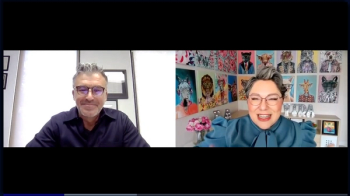
One patient connects 2 students who have never met
I have taught many students who have never met but are nonetheless connected
In my role as educator, I have taught 2 students who are connected despite having never met. The first student came to me in 1994, a year after I started practicing at the U.S. Department of Veterans Affairs. The second is a current pupil of mine and is only a few weeks away from collecting her Doctor of Optometry degree from the University of Alabama at Birmingham School of Optometry.
They are connected because each recently collaborated to save the vision of a patient who will likely not remember either of them, much less me.
Clinical findings
The patient is a 39-year-old man with a contact lens overwear-related central corneal ulcer. He was accompanied to the visit by his temporary caretaker sister, and he presented to our clinic at 3:00 p.m., of course, with a red, angry right eye of several days’ duration.
Clinical findings were straightforward enough: a 2 mm central ulcer with larger stromal infiltrate extending the full depth of the cornea from epithelium to an inflamed and wrinkled Descemet’s membrane; another smaller, peripheral satellite ulcer threatening to join forces with the first; obscured iris detail; no hypopyon, but still a hurricane of inflammatory cells roiling beneath the haze.
Visual acuity? Counting fingers at 2 feet.
To complicate matters, he wrestled with multiple substance abuse disorders and psychiatric conditions that made it difficult for him to fully comprehend the clear and present danger to his vision. Even under the best of circumstances, it is difficult and risky to treat corneal ulcers on an outpatient basis, and to trust patients to instill drops and ointment at a frequency high enough to control the infection.
Student A
The fourth-year extern was eager to try, though, and I knew she could learn the kind of nuanced lessons from treating and following a complex case that cannot be conveyed in a lecture hall or gleaned from a textbook.
Like most community-based practices, we decided to treat empirically for 24 hours, alternating a fourth-generation fluoroquinolone with a trimethoprim/polymyxin B combination eyedrop every 30 minutes while awake, along with a broad-spectrum ointment for use at bedtime plus a cycloplegic.
The patient’s sister listened carefully, taking it all in. Still, we wrote down the precise regimen for them. She promised to monitor him and help him use the medications as instructed.
The extern instilled a loading dose in the office, and we crossed our fingers and hoped for the best but prepared for the worst, discussing how we would proceed should our treatment fail to gain traction.
There was a time earlier in my career when a “hot case” would have occupied nearly all of my waking thoughts—and even a few nightmares—until the follow-up the next day.
As a seasoned traveler treading well-worn paths, it is easy for me to put one out of my mind until it is time to reengage.
So, I was a little surprised when the extern walked into my office the next day and presented the 24-hour findings. Her sentences fired off like a machine gun and words were flying the way they do when things are going very well or very badly.
“Wait, slow down, which eye was it again?” I interrupted to ask.
I honestly could not remember. Maybe my extern had mentioned laterality, but I might have missed it in her rapid-fire soliloquy.
Turns out she was excited because things were going very well. His vision had improved to 20/200. There was only a tiny epithelial defect, and the radial folds of the iris were starting to emerge like early morning sunrays piercing a dense fog. His pain had improved significantly.
Good news
“We are winning for now, but we have got to keep this up,” I told the patient and his sister.
Once vision and pain improve, it is common for patients to think they do not need as much medication and start missing doses. I reminded them both what was stake and prepared them for the likelihood that his vision would be reduced permanently even with a “good outcome.”
Over the next 72 hours there was more improvement, but by day 5 his progress plateaued.
“I don’t think he is getting worse, but he’s not getting any better, either,” my extern observed.
She was right. Further probing revealed his sister had not been able to keep tabs on him as much as she had hoped, he was not instilling the drops frequently enough, and, in fact, had lost his bottle of trimethoprim/polymyxin B drops.
“Oh, by the way,” his sister said, “he goes to the Tuscaloosa VA tomorrow for a 10-week treatment program.”
I had first one thought followed by another in rapid succession: “Damn it!” and “Oh wait, Lisa is there!”
Student B
Lisa Schifanella OD, MS, who started her externship in my clinic in January 1994, was initially undecided on a career path but had decided by the end to enter an ocular disease residency and pursue a career in academia. She has since taught at 2 different universities and serves today as residency and externship director at the Tuscaloosa, Alabama, Veterans Affairs Medical Center.
Along the way she, herself, instructed and mentored hundreds of students and residents, won multiple teaching awards, and generally surpassed in all ways her former externship preceptor. If you are a teacher and doing your job right, that is the way it should be.
Patient handoff
It was a seamless handoff. Not only did I have full confidence Dr. Schifanella would expertly manage the case, but I also knew she would write inpatient orders resulting in our now mutual patient receiving the right dosage of medication from the nursing staff, thereby solving the compliance problem.
With appropriate antibiotic therapy and judicious use of topical steroids, the cornea was quiet with mild residual scarring, and the patient’s vision was correctable to 20/25.
Conclusion
My current extern was thrilled to learn about our patient’s positive treatment outcome. At the beginning of this year, she—like Dr. Schifanella before her—was undecided on her career path.
Today, her first steps, at least, are clear. She recently matched at an ocular disease residency at a different VA medical center. And so, the cycle begins again.
If you stay in the game long enough, everything comes full circle. Turns out I have taught many students who have never met but are nonetheless connected.
They encircle me like markers on a clock that chimes not in hours but years. And they remind me, more than anything else I can think of, that I have spent my time well.
Newsletter
Want more insights like this? Subscribe to Optometry Times and get clinical pearls and practice tips delivered straight to your inbox.













































